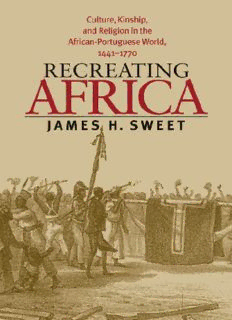
Recreating Africa: Culture, Kinship, and Religion in the African-Portuguese World, 1441-1770 PDF
Preview Recreating Africa: Culture, Kinship, and Religion in the African-Portuguese World, 1441-1770
|||||||||| Recreating AFRICA |||||||||| Culture, Kinship, and Religion in the African-Portuguese World, 1441–1770 J A M E S H . S W E E T the university of north carolina press ChapelHillandLondon ©2003TheUniversityofNorthCarolinaPress Allrightsreserved DesignedbyJacqulineJohnson SetinSabonbyTsengInformationSystems,Inc. ManufacturedintheUnitedStatesofAmerica Thepaperinthisbookmeetstheguidelinesfor permanenceanddurabilityoftheCommitteeon ProductionGuidelinesforBookLongevityofthe CouncilonLibraryResources. Thepublicationofthisbookwassupportedinpart bytheCollegeofArtsandSciencesofFlorida InternationalUniversity. LibraryofCongressCataloging-in-PublicationData Sweet,JamesH.(JamesHoke) RecreatingAfrica:culture,kinship,andreligion intheAfrican-Portugueseworld,1441–1770/ byJamesH.Sweet. p.cm. Includesbibliographicalreferencesandindex. isbn0-8078-2808-4(cloth:alk.paper)— isbn0-8078-5482-4(pbk.:alk.paper) 1.Blacks—Brazil—Religion. 2.Blacks—Brazil—Social conditions. 3.Slaveryandthechurch—Brazil— History. 4.Slaveryandthechurch—Catholic Church—History. 5.Afro-Braziliancults. 6.Brazil— Civilization—Africaninfluences. I.Title. f2659.n4s94 2003 981'.00496—dc21 2003001194 cloth 07 06 05 04 03 5 4 3 2 1 paper 07 06 05 04 03 5 4 3 2 1 contents Acknowledgments xi Introduction 1 part one: living and dying in the african-portuguese diaspora 1 Demography,Distribution,andDiasporicStreams 13 2 Kinship,Family,andHouseholdFormation 31 3 Disease,Mortality,andMasterPower 59 part two: african religious responses 4 Catholicvs.‘‘Other’’intheWorldofBelievers 87 5 TheoryandPraxisintheStudyofAfricanReligions 103 6 AfricanDivinationintheDiaspora 119 7 Calundús,Curing,andMedicineintheColonialWorld 139 8 Witchcraft,Ritual,andResistanceinthe African-PortugueseDiaspora 161 part three: africans and the catholic church 9 AfricanCatholicisminthePortugueseWorld 191 10 TheImpactsofAfricanReligiousBeliefson BrazilianCatholicism 217 Conclusion 227 Notes 231 Bibliography 265 Index 287 maps, tables, && illustrations maps 1 ThePortugueseColonialWorld 4 2 CentralAfrica,SeventeenthandEighteenthCenturies 17 3 AfricanNationsandEthnicitiesasTheyAppearin BrazilianDocuments 21 4 ColonialBrazil 25 5 PeopleandStatesofSenegambia,Sixteenthto EighteenthCenturies 88 6 PortugalandNorthAfrica,SixteenthCentury 92 tables 1 EthnicitiesandNationsofAfricanSlavesListedinthe WillsandTestamentsofSlaveholdersinRiodeJaneiro, 1737–1740 26 2 SlaveAcquisitionsoftheBenedictineMonasteryOurLady ofMonserrate,RiodeJaneiro,1620–1772 28 3 MarriagesInvolvingAfricansintheParishofNossaSenhora daCandelária,RiodeJaneiro,1751–1761 45 4 MarriagesInvolvingAfricansintheParishofSãoSalvadordo MundodeGuaratiba,RiodeJaneiro,1763–1770 46 5 MarriagesInvolvingAfricansRepresentedintheBaptismal RecordsoftheParishofSãoJosé,RiodeJaneiro, 1751–1758 48 6 CrudeDeathandBirthRatesonVariousBrazilian Properties,1617–1778 63 illustrations QuimbandainCentralAfrica,seventeenthcentury 55 Slavesinthetronco,nineteenthcentury 76 Capuchinpriestburninganidolhouse,Kongo,ca.1750 111 FuneralmassinKongo,ca.1750 114 Trialofjaji,CentralAfrica,seventeenthcentury 124 Angolanxinguilas,seventeenthcentury 141 FuneralprocessionofCongoleseroyalty,RiodeJaneiro, nineteenthcentury 143 CalundúinnortheastBrazil,seventeenthcentury 150 ImbangalaqueenTemba-Ndumba,seventeenthcentury 177 Fruitvendorwithbolsasdemandinga,RiodeJaneiro, ca.1776 180 CatholicmasscelebratedinKongo,ca.1750 192 Masterbeatinghisslavewithapalmatória,Brazil, nineteenthcentury 212 acknowledgments SeveralyearsagoattheAmericanHistoricalAssociationmeet- inginChicago,IwasonmywaytodinnerwithColinPalmer, MaryKarasch,andMonicaSchuler.Aswewereleavingthelobbyofthehotel, oneofthemspottedPhilipCurtinacrossacrowdedroom.Wemadeourway towhereCurtinwas,andPalmerintroducedmeasoneofhisstudents.Cur- tin’sreply,shortandpithy,wassimply,‘‘Ah,oneofmygrandchildren!’’ AsIponderedthissometimelater,Ibegantoappreciatethedeepermean- ingofCurtin’scomment.Istandontheshouldersofanimpressivegroupof scholars who fell under the influence of Curtin and JanVansina at the Uni- versityofWisconsinatMadisoninthelate1960sandearly1970s.Some,like Schuler,PaulLovejoy,andJoeMiller,weretrainedasAfricanists.Others,like Palmer,Karasch,andFranklinKnight,weretrainedprimarilyasLatinAmeri- canists.Butthecommondenominatorinalloftheirworkisanemphasison the breadth and scope of what has come to be called the African diaspora. Long before therewas a discrete field known as ‘‘African diaspora’’ history, CurtinandVansinawereproducingsomeofthefinestdiasporascholarsinthe world.Morethanafewofthesescholarshaveinfluencedthismanuscript.In recognitionofthisrichlegacy,Ibeginbythankingtwoofthe‘‘grandfathers’’ ofAfricandiasporahistoricalstudy,PhilipCurtinandJanVansina. Byfar,themostimportantpersoninmyintellectualdevelopmenthasbeen ColinPalmer.PalmertookaninterestinmewhenIwasanundergraduateat the University of North Carolina. Supervising my ‘‘duties’’ as a work-study studentinthedepartmentofhistory,hewouldoftenfindmedozingwithmy headburiedinahalf-finishedcrosswordpuzzle.Oneday,perhapscuriousto see how shiftless I really was, he asked to read a paper I had written on the Sandinista revolution in Nicaragua.To his surprise, the paper was engaging xi and well written (or so he claims). From that day forward, he has refused to allow me to settle for mediocrity. As an adviser, critic, and friend, he has been unwavering in his support. I can only hope that the publication of this bookwillinsomewayjustifytheenergyandtimehehasinvestedinme.For everything,Iameternallygrateful. Othermentorsandcolleagueshavebeeninstrumentalinhelpingmealong theway. In my first yearof graduate school, John Chasteen, beyond being a friendlyandinsightfulcritic,emphasizedtheimportanceofwritingandstyle tothehistorian’scraft.HeimprovedmywritinginwaysthatIhopewillre- main our secret.Carter Doughertyand Patrick Rivers were colleagues, crit- ics,andgoodfriendswhileIwasinChapelHill.LydiaLindseyandCarlton WilsonatNorthCarolinaCentralUniversitywerebothimmenselyhelpfulin theirsuggestionswhenIwaswritinguptheearlyresearchthateventuallyled tothisbook. At the City University of NewYork, I would like to thank David Nasaw forhisadviceandsupportwhenIwasaPh.D.student.MichaelYudellmade mymoveandadjustmenttothecityfareasier.TeofiloRuizwasaninfluential teacher,critic,andfriendbeforedepartingforgreenerpasturesattheUniver- sityofCalifornia–LosAngeles.AdaFerreratNewYorkUniversityprovided astimulatingseminaronLatinAmericanandCaribbeanhistoryandwasgra- ciousenoughtoserveonmyoralexamcommittee.MegCrahan,SusanBesse, Donald Robotham, and James Oakes served on my dissertation committee, someofthemonshortnotice.SpecialthankstoProf.Crahan,whoalongwith Colin Palmer, was one of my primary readers. Her advice and suggestions wereinvaluablethroughoutmygraduatetraining. JohnThorntonandLindaHeywoodreadanearlydraftofthemanuscript, providing thorough critiques and suggestions, particularly from the Central Africanperspective.ThorntonreadthemanuscriptasecondtimefortheUni- versityof North Carolina Press, again making important suggestions for re- vision.Thornton also helped with translations of Central African languages andgavemeaccesstoseveralofhisforthcomingarticles.AlthoughThornton andIdisagreeonsomeofthefinerpointsofCentralAfricanreligion,hehas remainedasteadfastsupporterofthisproject,demonstratingaspiritofcol- legialityand mentorship that will serve as a model as I move forward in my career.Hiscontributionshavemadethisaninfinitelybetterbook. IwouldalsoliketothankthePress’ssecondreader,MaryKarasch,whose closeandcarefulreadingofthemanuscriptwasinstrumentalinshapingmyre- visions.Karaschprovideddetailedsuggestionsthathaveimprovedthebookin countlessways.Othershavealsocommentedandmadevaluablesuggestions. Paul Lovejoy and David Richardson provided encouraging comments when xii acknowledgments theyheardmedelivertheconferencepapersthatformthecoresofChapters 6and7.JoeMillerreadportionsofthemanuscriptandprovidedimportant feedback. In the book’s final stages,Wyatt MacGaffey, Roque Ferreira, and TerryReymadeimportantcontributions.Thankstothemall. ElaineMaisner,myeditorattheUniversityofNorthCarolinaPress,shep- herded the manuscript through its various stages, making many useful sug- gestions along theway. Elaine’s patience and enthusiasm made the daunting processoffirst-timepublicationatrulyenjoyableexperience. AsIwasconductingtheresearchforthebook,Iincurredanumberofdebts. Without the financial support of a Fulbright-Hays Fellowship and a Social ScienceResearchCouncilInternationalDissertationResearchFellowship,the research could not have been completed. In Portugal, the staffs of various librariesandarchiveswereconsistentlyhelpful.Particularpraiseisduetothe staff of the Arquivo Nacional doTorre deTombo, whose patience and alac- rity were tested daily as I sorted through documents from dozens of Inqui- sitioncases.Ialsobenefitedfromthegoodwillandcomraderieoftwoother FulbrightfellowsinLisbon,MichaelKerlinandAmyBuono.Theircompan- ionshipandgoodhumormadebeingawayfrommyfamilyfareasier.InBra- zil, Aloysio de Oliveira Martins Filho, director of the Arquivo da Curia in Rio, took great interest in my project and made my work there go quickly andsmoothly.ThestaffoftheArquivoNacionalalsowentaboveandbeyond thecallofduty,allowingmeaccesstofragilemanumissiondocumentsfrom the eighteenth century, documents that remain badly in need of restoration. Finally, the staff at theVatican Film Libraryat Washington University in St. Louiswereefficientandcourteous. Whileprofessionaldebtsareimportanttoacknowledge,mytrajectoryasa historianhasbeeninfluencedprimarilybyfriendsandfamily.TonyScottand ToddMcMastershavebeenlife-longfriendsandsupporters.Icouldneverre- payeitherofthemfortheirdecency,loyalty,andgoodsense.Iwouldberemiss ifIdidnotthankDennyDenison,CliveHarriott,VinsonJenkins,DanaLums- den, Susan Morgan, Kiko Nakano,Warren Robinson, JamesTaylor,Valerie Williams,andCedricWoods.Inwaysbigandsmall,youallformthefounda- tionofmyhistoricalconsciousness.TomyfamilyinSouthAfrica,inopening upyourheartsandhomestousonayearlybasis,younotonlyproviderespite fromthegrindofwork,butyoureaffirminustheparamountimportanceof ancestors,family,andkinship.Margaret,Ali,andIareproudtocallourselves Lekoma, Mabale, Motsepe, and Ramaphosa, as well as Sibilsky and Sweet. Weareenrichedandmadelargerbyyouall. Finally, there are three peoplewhose influence in my life has simply been immeasurable.Mymother,LynSweet,dedicatedalargeportionofherlifeto acknowledgments xiii
Description: